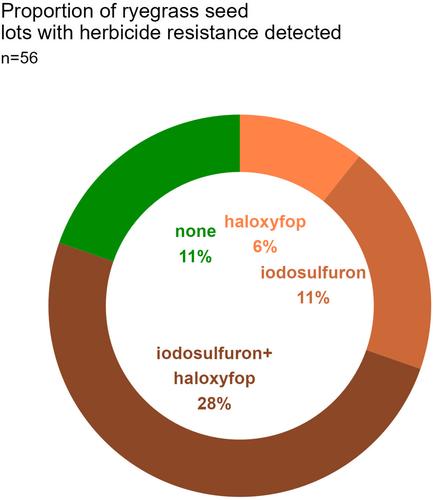当前位置:
X-MOL 学术
›
Pest Manag. Sci.
›
论文详情
Our official English website, www.x-mol.net, welcomes your
feedback! (Note: you will need to create a separate account there.)
Resistance to the herbicides haloxyfop and iodosulfuron is common in commercial ryegrass (Lolium) seed lines
Pest Management Science ( IF 3.8 ) Pub Date : 2025-01-20 , DOI: 10.1002/ps.8665
Christopher E Buddenhagen, Zachary Ngow, Ben Wynne‐Jones, M. Philip Rolston
Pest Management Science ( IF 3.8 ) Pub Date : 2025-01-20 , DOI: 10.1002/ps.8665
Christopher E Buddenhagen, Zachary Ngow, Ben Wynne‐Jones, M. Philip Rolston

|
BackgroundRyegrass (Lolium spp.) is a key forage providing a $14 billion contribution to New Zealand's gross domestic product (GDP). However, ryegrass can also act as a weed and evolve resistance to herbicides used for its control. Farmers suspected that imported seed might contribute to resistance issues. Herbicide resistance frequencies were investigated in commercial ryegrass seed lines intended for multiplication in New Zealand. Samples from 56 basic seed lots and 52 unique cultivars sourced from regions including New Zealand, United States, Europe and Japan were planted in field trials. Seedlings were then sprayed with three common herbicides: glyphosate, iodosulfuron, and haloxyfop. Surviving plants were retested to confirm resistance.ResultsResistance to haloxyfop and or iodosulfuron was detected in 79% of seed lines. However, frequencies were not significantly higher in imported lines (from United States and Europe) compared with New Zealand lines. Resistance was detected at frequencies between 0.00112% and 10% for haloxyfop and between 0.00212% and 14.28% for iodosulfuron Resistance to glyphosate was not found. There was no significant difference between the resistance detected in seed samples sourced from different seed companies.ConclusionsIt was found that 63% of resistant lines had resistance frequencies rarer than 0.1%, but this is potentially problematic considering typical sowing rates. Imported versus domestic seed sources were not significantly different; they pose similar levels of resistance risk to farmers. Lolium multiflorum had a higher resistance frequency compared to Lolium perenne (although only six L. multiflorum lots were evaluated). Breeders should screen progeny of early crosses for herbicide resistance. © 2025 The Author(s). Pest Management Science published by John Wiley & Sons Ltd on behalf of Society of Chemical Industry.
中文翻译:

对除草剂 haloxyfop 和碘嘧磺隆的抗性在商业黑麦草 (Lolium) 种子系中很常见
背景黑麦草 (Lolium spp.) 是一种重要的牧草,为新西兰的国内生产总值 (GDP) 贡献了 140 亿澳元。然而,黑麦草也可以充当杂草,并产生对用于控制其的除草剂的抗性。农民怀疑进口种子可能会导致耐药性问题。在新西兰用于繁殖的商业黑麦草种子系中研究了除草剂抗性频率。来自新西兰、美国、欧洲和日本等地区的 56 个基本种子批次和 52 个独特品种的样品在田间试验中种植。然后用三种常见的除草剂喷洒幼苗:草甘膦、碘嘧磺隆和卤氧氟草。对存活的植物进行重新测试以确认抗性。结果在 79% 的种子品系中检测到对 haloxyfop 和/或碘嘧磺隆的抗性。然而,与新西兰线路相比,进口线路(来自美国和欧洲)的频率并没有显著提高。在 0.00112% 和 0.00112% 之间的频率下检测到 haloxyfop 的耐药性,在 0.00212% 和 14.28% 之间的碘嘧磺隆之间未发现对草甘膦的耐药性。在来自不同种子公司的种子样品中检测到的抗性之间没有显著差异。结论发现 63% 的抗性品系的抗性频率低于 0.1%,但考虑到典型的播种率,这可能是个问题。进口种子来源与国内种子来源没有显著差异;它们对农民构成类似程度的耐药性风险。与 Lolium perenne 相比,Lolium multiflorum 具有更高的抗性频率(尽管仅评估了 6 个 L. multiflorum 批次)。育种者应筛选早期杂交的后代是否具有除草剂抗性。© 2025 作者。 由John Wiley & Sons Ltd代表化学工业协会出版的《害虫管理科学》。
更新日期:2025-01-20
中文翻译:

对除草剂 haloxyfop 和碘嘧磺隆的抗性在商业黑麦草 (Lolium) 种子系中很常见
背景黑麦草 (Lolium spp.) 是一种重要的牧草,为新西兰的国内生产总值 (GDP) 贡献了 140 亿澳元。然而,黑麦草也可以充当杂草,并产生对用于控制其的除草剂的抗性。农民怀疑进口种子可能会导致耐药性问题。在新西兰用于繁殖的商业黑麦草种子系中研究了除草剂抗性频率。来自新西兰、美国、欧洲和日本等地区的 56 个基本种子批次和 52 个独特品种的样品在田间试验中种植。然后用三种常见的除草剂喷洒幼苗:草甘膦、碘嘧磺隆和卤氧氟草。对存活的植物进行重新测试以确认抗性。结果在 79% 的种子品系中检测到对 haloxyfop 和/或碘嘧磺隆的抗性。然而,与新西兰线路相比,进口线路(来自美国和欧洲)的频率并没有显著提高。在 0.00112% 和 0.00112% 之间的频率下检测到 haloxyfop 的耐药性,在 0.00212% 和 14.28% 之间的碘嘧磺隆之间未发现对草甘膦的耐药性。在来自不同种子公司的种子样品中检测到的抗性之间没有显著差异。结论发现 63% 的抗性品系的抗性频率低于 0.1%,但考虑到典型的播种率,这可能是个问题。进口种子来源与国内种子来源没有显著差异;它们对农民构成类似程度的耐药性风险。与 Lolium perenne 相比,Lolium multiflorum 具有更高的抗性频率(尽管仅评估了 6 个 L. multiflorum 批次)。育种者应筛选早期杂交的后代是否具有除草剂抗性。© 2025 作者。 由John Wiley & Sons Ltd代表化学工业协会出版的《害虫管理科学》。































 京公网安备 11010802027423号
京公网安备 11010802027423号